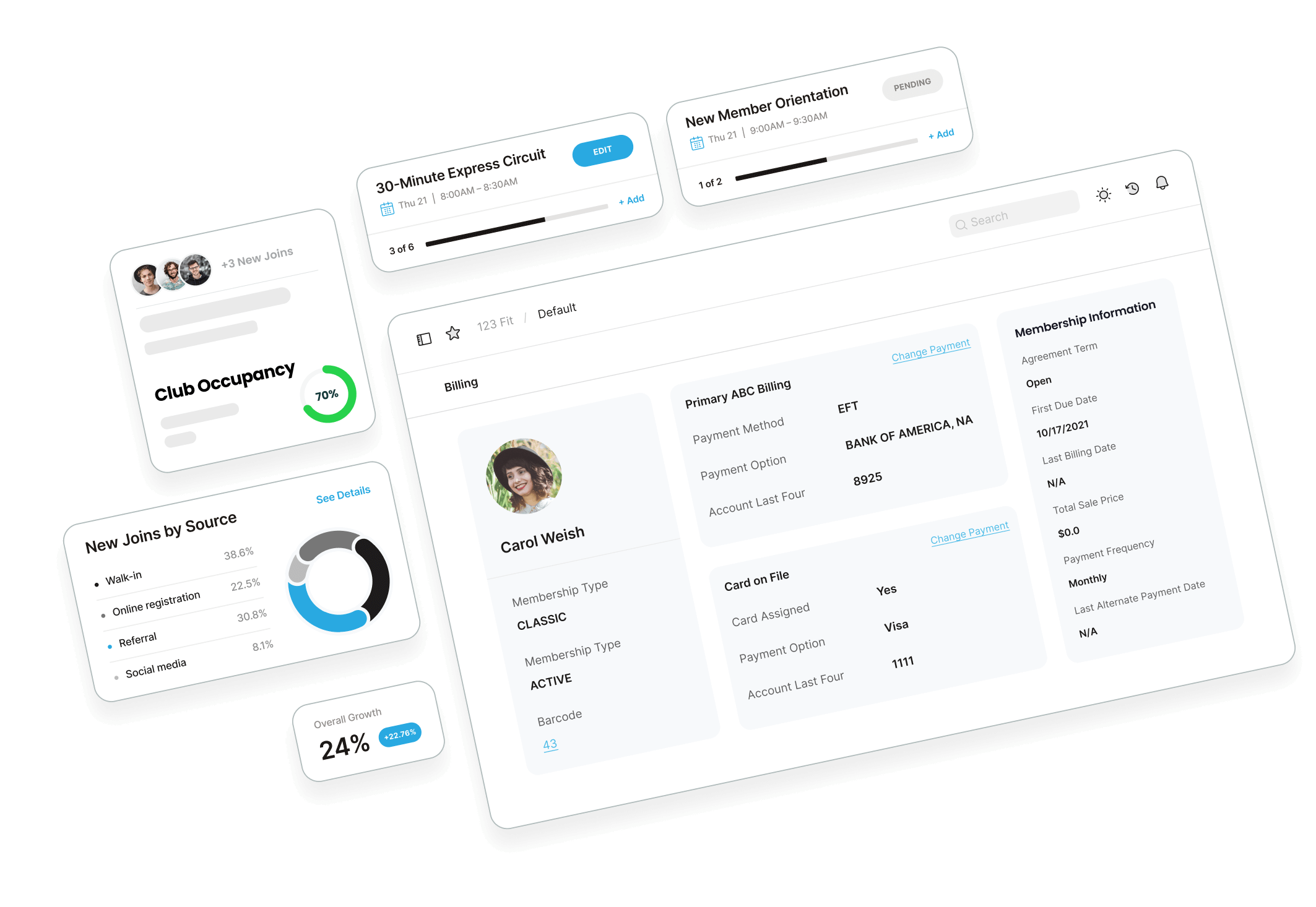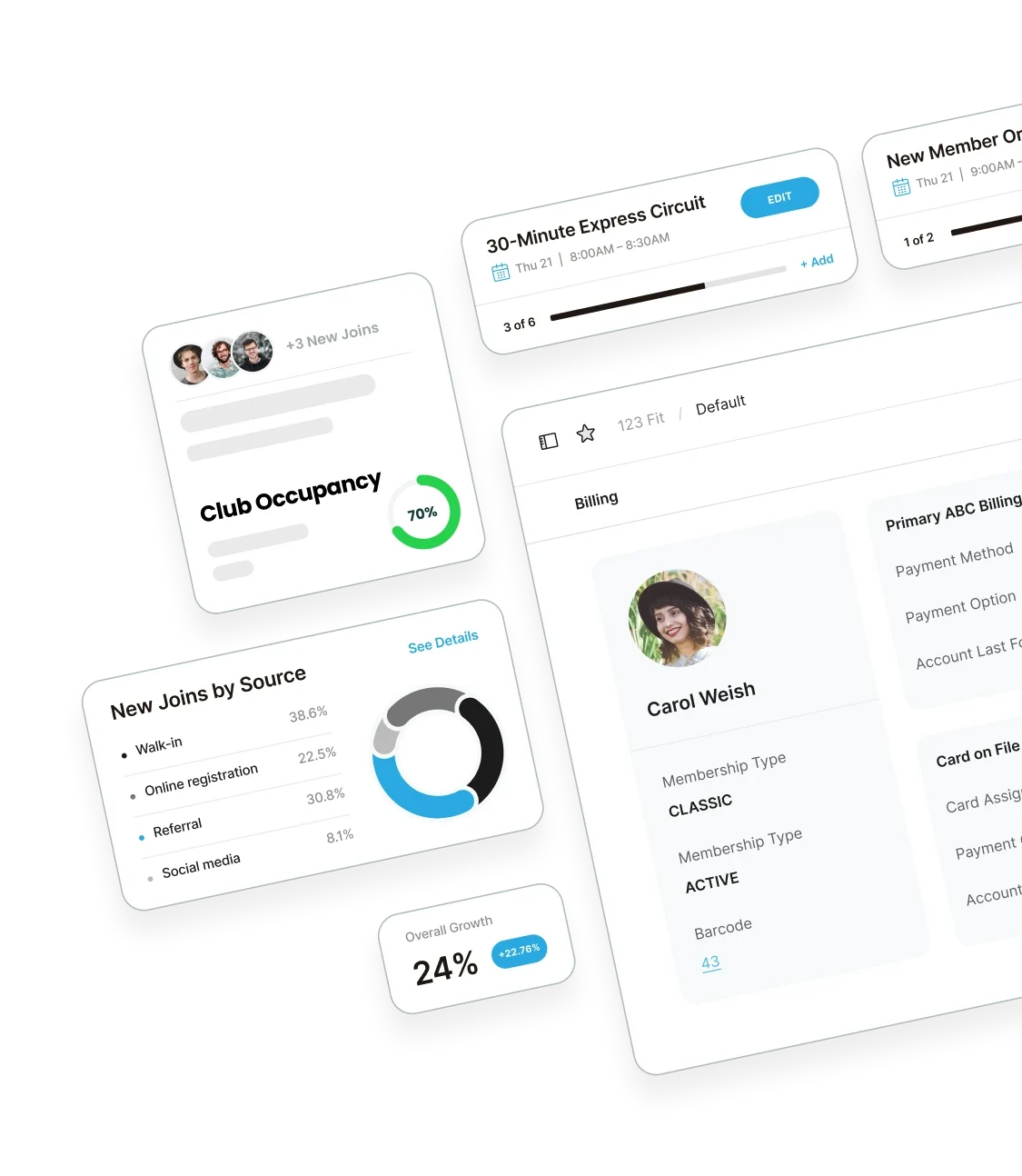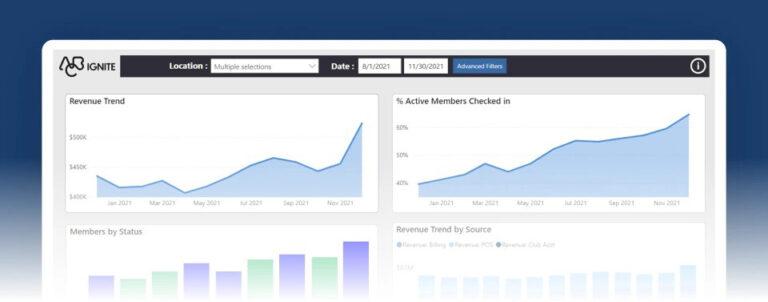In the competitive landscape of the fitness industry, running a profitable gym requires more than just offering quality equipment and training sessions. To thrive, gym owners must monitor key performance indicators (KPIs) to track their business’s financial health and growth. With the help of modern gym management tools (like ABC Ignite), owners can gain valuable insights into their operations and make informed decisions.
In this guide, we’ll discuss the essential KPIs that every gym owner should track to ensure profitability and long-term success, including member lifetime value, staffing efficiency, and more.
Continue reading to uncover the metrics that drive profitability and growth. But first, let’s discuss why KPIs are important to your success.
What are KPIs and Why are They Important?
A KPI is a metric you’ve chosen to gauge the success of a specific aspect of your business. Tracking this designated KPI over time allows you to witness improvements and areas where your business may be underperforming, providing valuable insights for growth and refinement.
Remember, having extended knowledge about your business gives you the power to do more of what works and make changes when something isn’t working.
Six KPI Categories for Business Success
There are various KPIs you can use to assess your gym or club’s performance. In this guide, we’ll simplify them into six categories:
- Conversion
- Lifetime Value
- Secondary Sales
- Multi-Club
- Club Use
- Revenue
Let’s break each of these down further.
1. Conversion
Conversion KPIs are used to measure the effectiveness of converting potential customers into actual paying members. These KPIs provide valuable insights into the performance of marketing and sales efforts, helping fitness businesses evaluate their conversion strategies and identify areas for improvement.
Some common conversion KPIs include:
- Conversion Rate: For gym owners, this could measure the percentage of website visitors who sign up for a free trial, schedule a tour, or become members after visiting the gym’s website or landing page. A high conversion rate indicates that your gym or club’s online presence is effective at converting interested individuals into potential members.
- Lead-to-Customer Conversion Rate: This KPI tracks the percentage of leads, such as individuals who inquire about membership or schedule a tour, who eventually become paying members. It helps to assess the effectiveness of your sales process in converting leads into customers and identify areas for improvement.
- Cost per Acquisition (CPA): CPA measures the average cost incurred to acquire a new gym member. This includes expenses related to marketing campaigns, promotions, and sales efforts. Use this KPI to evaluate the efficiency of your marketing channels and allocate resources to those that yield the lowest cost per acquisition.
- Abandonment Rate: For those who manage fitness businesses, this could measure the percentage of individuals who start the membership signup process online but abandon it before completion. High abandonment rates may indicate issues with the signup process, pricing transparency, or website usability that need to be addressed to improve conversion rates.
- Sales Conversion Cycle: This KPI measures the average time it takes for a lead to become a paying member, from the initial inquiry or signup to membership activation. You can use this metric to identify bottlenecks in the signup process, streamline operations, and provide personalized follow-up to shorten the conversion cycle and improve member acquisition efficiency.
2. Lifetime Value
Lifetime value KPIs evaluate the long-term financial value generated by individual customers over their entire relationship with a business. These KPIs can help gym owners understand the profitability of acquiring and retaining members. Examples include:
Grow Your Business: Access 2024's Top Fitness Trends Now
Download- Member Lifetime Value (MLV): MLV measures the total revenue generated throughout a membership. It includes membership fees, personal training sessions, merchandise purchases, and additional services. It can help you understand the long-term value of acquiring and retaining your members, as well as guide decisions related to member retention strategies.
- Average Revenue Per Member (ARPM): ARPM calculates the average revenue generated by each gym member over a specific period, such as a month or a year. It provides insights into member spending habits and helps to identify opportunities for upselling additional services, such as personal training sessions or nutritional consultations.
- Member Retention Rate: The member retention rate measures the percentage of gym members who renew their memberships over time. Higher retention rates contribute to increased MLV as long-term members generate more revenue for the gym through ongoing membership fees and additional purchases.
- Churn Rate: The churn rate measures the percentage of members who cancel their memberships over a specific period. A high churn rate can negatively impact MLV as it represents lost revenue from members who no longer contribute to your gym’s financial health.
3. Secondary Sales
Secondary sales KPIs track any additional revenue generated from existing customers beyond their initial membership. Some examples include:
- Cross-Sell Rate: This KPI measures the percentage of gym members who purchase additional services or products beyond their membership. This could include personal training sessions, nutritional supplements, fitness apparel, or access to premium amenities such as sauna or massage services.
- Upsell Rate: Gym owners can track the upsell rate to measure the percentage of members who upgrade their memberships or purchase higher-tier packages. For example, members may upgrade from a basic membership to a premium membership with additional perks or access to exclusive facilities.
- Average Order Value (AOV): AOV for gym owners calculates the average amount spent by members on additional purchases or services during each transaction. This could include purchases made at the gym’s retail store, cafe, or booking additional classes or sessions.
- Referral Rate: The referral rate tracks the percentage of gym members who refer new members to the gym. Implementing a referral program encourages existing members to spread the word about the gym’s offerings, attracting new customers and driving secondary sales.
- Renewal Rate: For gyms offering subscription-based memberships, the renewal rate measures the percentage of members who renew their memberships after the initial term expires.

4. Multi-Club
Multi-location gym KPIs assess the overall performance and efficiency of multiple gyms or fitness clubs. Ensuring consistency in tracking these metrics across all clubs is essential, as it allows for accurate comparisons and informed decision-making. Using one platform for all locations streamlines operations and prevents incomplete data. Implementing reporting automation can also provide timely information without the burden of manual tracking, offering immediacy, accuracy, and consistency in performance evaluation.
Here are several examples of multi-location KPIs:
- Total Revenue: Total revenue measures the combined revenue generated by all clubs within the organization over a specific period, such as a month, quarter, or year. It provides an overview of all your locations’ financial health and performance.
- Member Growth Rate: Member growth rate tracks the percentage increase or decrease in the total number of members across all clubs within the organization over time. It can help you assess the effectiveness of marketing and sales efforts in attracting new members and retaining existing ones.
- Average Visit Frequency: Average visit frequency calculates the average number of visits per member across all clubs within the organization. It provides insights into member engagement and helps identify opportunities to enhance the member experience and encourage repeat visits.
5. Club Use
This KPI measures the efficiency and effectiveness of gym or fitness club facilities. It provides insight into how well the club’s resources, such as equipment, space, and staff, are used to meet member demand and optimize operational performance. Some examples include:
- Occupancy Rate: The occupancy rate measures the percentage of available gym capacity at any given time. It helps gym owners and managers understand how effectively their facility is being used and identify peak hours.
- Class Attendance Rate: The class attendance rate measures the percentage of available spots in group fitness classes filled by members. It helps assess the popularity and demand for different types of classes. It can also help optimize class scheduling and capacity to meet your member’s needs.
- Staffing Efficiency: Staffing efficiency evaluates the ratio of staff members to members or the club activity level. It helps gym owners optimize staffing levels based on member demand, ensuring enough staff members are available to help while maintaining a safe and enjoyable environment for members.
- Peak Hours Analysis: Peak hours analysis identifies the busiest times of day or week within your gym. It can help you anticipate high-traffic periods and allocate resources accordingly, such as scheduling additional staff or ensuring sufficient equipment availability.
6. Revenue
Revenue metrics track financial performance and income generated by your gym or club. They provide insights into the effectiveness of revenue-generating strategies and help you identify opportunities for growth and revenue optimization. Understanding them is truly the foundation of running a profitable business.
Here are some essential revenue metrics:
- Total Revenue: Total revenue measures the overall income generated by the gym from all sources, including membership fees, personal training sessions, retail sales, and other revenue streams.
- Membership Revenue: Membership revenue specifically tracks the income generated from membership fees paid by gym members.
- Retail Revenue: Retail revenue tracks the income generated from selling fitness products, apparel, supplements, and other merchandise available at the gym.
- Personal Training and Class Revenue: These two metrics measure the income generated from group fitness classes, workshops, and special events offered by the gym and from one-on-one or group personal training sessions.
- Renewal Revenue: Renewal revenue measures the income generated from membership renewals within a specific period.
How to Access Your Gym’s KPIs
If you haven’t been keeping track of these crucial KPIs and are eager to access this valuable information, it’s time to consider ABC Ignite.
Our comprehensive end-to-end club management and sales automation platform is tailored specifically for gyms and health clubs. It’s a unified, holistic platform that allows you to pull data from all areas seamlessly, providing a single source of truth and offering a full picture without fragmentation.
ABC Ignite also offers reporting automation, eliminating the need for manual work. In addition to over 30 pre-built dashboards, you can customize and create your dashboards tailored to your specific needs—all automated for immediate access. Our gym management software also simplifies performance analysis, offering insights into your business’s financial health and facilitating informed decision-making.






